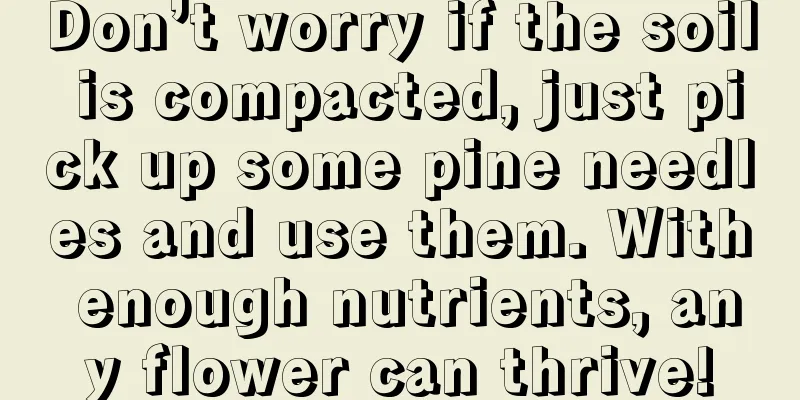Don’t worry if the soil is compacted, just pick up some pine needles and use them. With enough nutrients, any flower can thrive!

|
In fact, it is very common for the soil to become compacted during the flower-growing period, because the nutrients in the soil matrix itself are limited. If they are absorbed by the roots but not fully replenished, they will become dry and cracked. At this time, we need to add something to help the soil restore nutrients so that the growth of the plants can return to normal. Many times when we encounter signs of soil compaction, the first thing we want to do is to use a shovel, but this is not feasible. Because the soil is compacted and cracked, the roots of the flowers in it are almost stuck to the soil. If we use a shovel directly to dig, it may damage the flower roots. If the roots of the flowers are damaged, the growth of the plants will naturally not be good. Add some small things to the soil to help restore nutrients. We can choose to add some pine needles. Although pine needles are inconspicuous, when mixed with the soil, they can enhance the nutrients and air permeability of the soil, thereby promoting the growth of plants. Moreover, pine needles are found everywhere in our daily life, and they are free to use and have good effects. Because pine needles are also from the plant family, the nutrients they contain are relatively mild and easy to absorb. In addition, their texture is very hard. When we mix them with soil, they can enhance its air permeability and looseness. Before using pine needles, we need to expose them to the sun for disinfection. After all, they are collected from outdoors and must contain more bacteria and impurities. After processing the pine needles, we can choose to place them at the bottom of the flowerpot as base fertilizer or directly mix them with the soil to enhance nutrients. This can greatly improve the compacted soil and restore its original air permeability and nutrition. Soil compaction is actually a common problem in flower cultivation. If we remember to use the correct method to improve it, it will not affect the growth of the plants too much. I wonder how everyone improves the problem when they encounter soil compaction? You can share it together. |
Recommend
What soil is suitable for growing wolfberry?
Introduction to wolfberry Wolfberry is a plant of...
How to save seeds and propagate the beauty jiao
How to keep the seeds of Meirenjiao Beauty Banana...
Can grapefruit trees be potted?
Can grapefruit trees be potted? The pomelo tree c...
Side effects and contraindications of honeysuckle, functions of honeysuckle
1. Side effects and contraindications 1. Do not d...
Feeding and management of geese in winter
Geese raised in winter have strong vitality, a sh...
The green ivy looks like it has been painted green, and everyone praises it. The secret is... you can learn it in one go!
How to save the green radish at home when it turn...
Hurry up and shave the flowers, they will bloom in a month, otherwise it will be too late!
Petunia 1. Although some flower lovers’ petunias ...
Tips for growing Kalanchoe green Paris
1. Lighting Green Paris grows best in places with...
How to use fertilizer for money tree? Can money tree use urea?
1. Fertilization time When the money tree is pott...
Why do camellia leaves turn yellow after transplanting?
1. Wrong time The time to transplant camellia is ...
How to choose Dendrobium candidum and how to eat it after buying it
1. How to choose 1. Appearance: When buying Dendr...
How to grow butterfly flower
1. Soil When caring for Cleome, as long as the so...
How long is the growth cycle of mung beans?
Introduction to Mung Bean Growth Mung bean is a l...
How to grow Hawaiian coconut in autumn
1. Maintenance methods 1. Light: Although it is r...
Endless Summer Hydrangea Maintenance Methods and Precautions
Maintenance method: Sunlight: This flower loves s...









